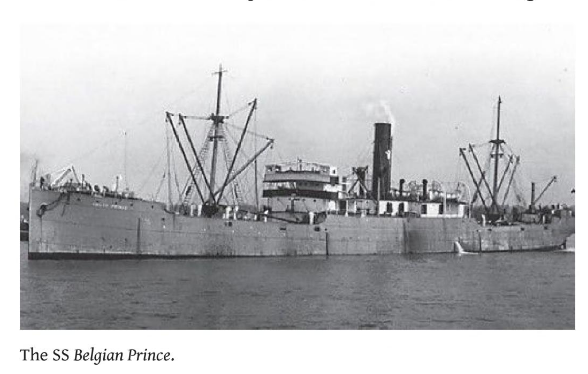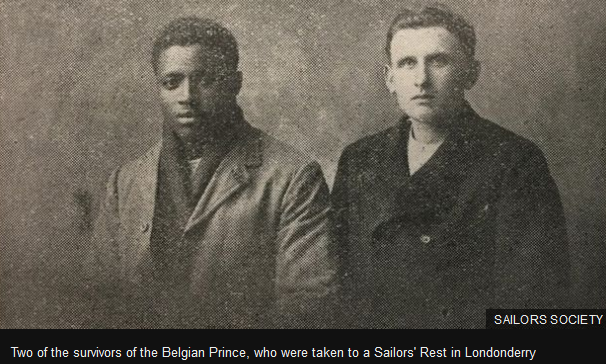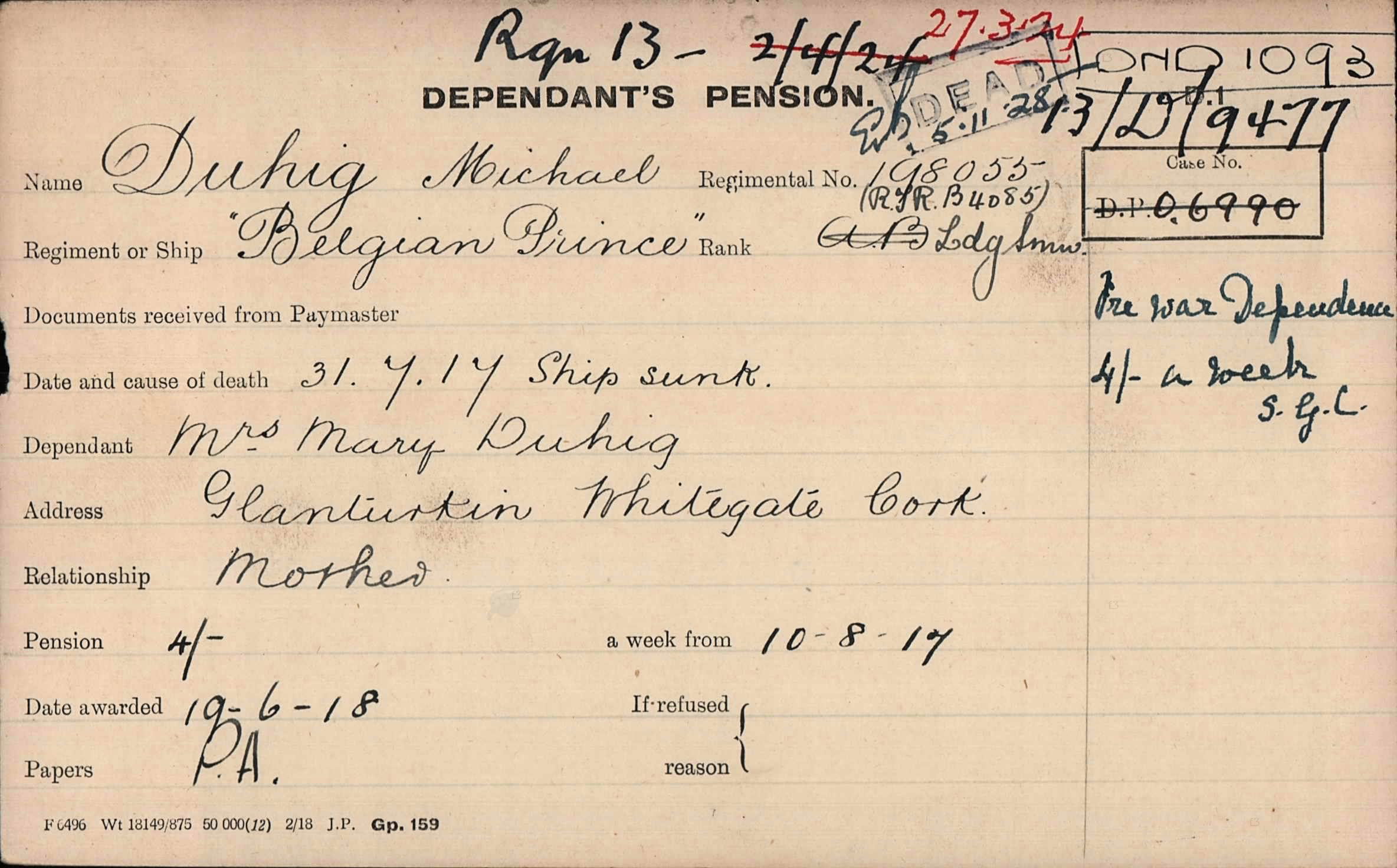Leading Seaman Michael Duhig and Germany's Worst Crime of the Great War

On the night of 31 July 1917, the SS “Belgian Prince” was torpedoed by the German submarine, U-55, 175 miles North West of Tory Island. The incident occurred when the ship was traveling from Liverpool to Newport News, Virginia, in the United States, with a cargo of blue clay – which is rich in minerals. That night, thirty-nine men drowned. Harry Hassan, the Master of the ship was captured and taken below deck on the U-boat, never to be seen again. Among the crew was Leading Seaman Michael Duhig from Glanturkin, Whitegate, Co. Cork.
Michael Duhig was born on 5 December 1881, in the townland of Glanturkin near Whitegate, Co. Cork. His parents were Jeremiah and Mary Duhig (née Lynch). After he left school, Michael travelled to Davenport, England. He enlisted in the Royal Navy on 1 December 1898 for an engagement period of twelve years. According to his record he was eighteen years old, five feet – four and a half inches tall, had brown hair, green eyes and was of fair complexion. His first ship’s posting was HMS “Black Prince” on 1 February 1898 with the rank of Boy 2nd Class. He subsequently served on HMS “Minotaur”, HMS “Agincourt” (a Minotaur class, training ship) and HMS “Thunderer” (A Devastation class). From 26 March 1900 until 22 June 1903 Michael Duhig, served on HMS “Goliath” and rose to the rank of Able Seaman, his naval profession being a seaman gunner.
During this same period, HMS “Goliath” was deployed to the China Station. The primary role of this station was the maintenance and repair of Royal Navy ships and the supply of naval stores and victuals. It also looked after communications with the Admiralty in London, the relief of crews at the end of a commission and the replacement and re-commissioning of ships at regular intervals. HMS “Goliath” was a pre-dreadnought battleship of the Canopus class, which was commissioned into the fleet on 27 March 1900. Michael’s time on at the China Station earned him the China Medal 1900. This was a British campaign medal approved on 1 January 1902 for issue to British and Indian land and sea troops who served during the Boxer Rebellion, between 10 June and 31 December 1900. Michael received his award (medal, number 4700) on 2 December 1902.
On 13 May 1915, during the Gallipoli campaign, HMS “Goliath” was torpedoed three times and sunk by the Turkish torpedo boat destroyer Muâvenet-i Millîye taking 570 of her 700 crew to the bottom of the sea. Seventy-three Irish men died during the sinking of the ship, sixteen of them from Cork. They included Leading Seaman Michael Coleman and Gunner Charles McCarthy, both men from Aghada. Michael Duhig, however, had left HMS “Goliath” by that stage. In September 1909, he was posted to HMS “Flora”, an Astraea-class cruiser for two years. The 1911Census/Sea Record has him back in the China Station. On 2 December 1911, he completed his twelve-year term in the Royal Navy and the following day he was enlisted into the Royal Fleet Reserve (R.F.R.) at Devonport. On 11 October 1914, following the outbreak of the Great War, Michael Duhig was transferred back to the Royal Navy and sent to HMS “Vivid”, the Naval Depot at Devonport. A short time later, on 24th October 1914, he was posted to HMS “London” which was part of the Channel Fleet. On 25 April 1915, that ship, with Michael on board, was off the Gallipoli Peninsula, supporting ANZAC forces as they landed at Gaba Tepe and Anzac Cove. It remained in the Mediterranean, supporting the Italian Royal Navy in the Adriatic Sea until October 1916.
On 27 October 1916, Michael returned to HMS Vivid. After a short spell he was on the move again, this time to HMS “President III”, an accounting base for the Royal Fleet Reserve, Royal Naval Reserve (R.N.R) and the Royal Naval Volunteer Reserve (R.N.V.R). It was also the headquarters for the personnel on Defensively Armed Merchant Ships (D.A.M.S). These men were paid extra pay and entitled to extra pensionable service. One of these ships was the SS Belgian Prince and among its crew was Michael Duhig.

The SS Belgian Prince
Built in 1901 by Sir James Laing & Sonhks Ltd, Sunderland (Yard No.578) as the S.S “Mohawk” a cargo ship for the Megnatic Steamship Company in Bristol, it would have a number of owners; the Megnatic Steamship Company, Bristol (1901-1902) and the North Atlantic Shipping Company, London (1902 – 1912) In February 1912, the ship was sold to the Prince Line Ltd, Newcastle and was renamed “Hungarian Prince”. In 1915, as the Great War entered its second year, it was renamed “Belgian Prince” since Hungary was then an enemy nation. In 1916, James Knott, the owner of Prince Line Ltd sold it to Furness Withy “primarily because James Knott had three sons, two were killed in action during the Great War and the third was posted missing but was later discovered to be a prisoner of war in Gallipoli”. The SS “Belgian Prince” was 391ft in length with a 51.2ft beam, single screw engine with a gross weight of 4,765 tons.
In Sir Archibald Hurd’s book, The Merchant Navy, Volume 3, he talks about Germany’s intensive submarine campaign during the period of July 1917 - November 1918:
The two months, July and August 1917, were marked by a welcome reduction in the amount of damage done to merchant shipping by the intensive submarine campaign. The number of British vessels sunk in July was 88 and in August, 84. These losses were still terribly high, but they compared favorably with the total of 116 for June and 155 for April. They represented a gross tonnage of 319,931 and 310,551 respectively, and they were accompanied by the loss of 401 lives (passengers and crews) in July and 415 in August.
On 26 July 1917, the SS “Belgian Prince” with its forty-three man crew which included Leading Seaman (Gunner) Michael Duhig, left Liverpool for the last time. Its destination port was Newport News with its cargo of blue clay. On 31 July 1917 at approximately 19:50 hours, approximately 175 miles North West of Tory Island, County Donegal, a torpedo fired by U-55, which was commanded Kapitänleutnant Wilhelm Werner, struck the ship without warning on its port side between the engine room and the number five hold, disabling the engines and causing the ship to list. All the crew survived the explosion and clambered into three lifeboats. At the same time, the submarine surfaced and commenced firing at the stricken vessel with the intention of disabling the wireless.
Werner then steered U-55 towards the crew in their lifeboats. When the three lifeboats were alongside, he ordered the men out onto U-55’s sea deck. The Master, Harry Hassan, was taken prisoner and taken below deck. The men were interrogated and asked if they had any weapons and were then robbed of their possessions by the Germans. They were also stripped of their overcoats and were left standing on the sea deck. Werner then ordered his men to destroy the lifeboats with axes and once this was done, he ordered them below deck and shut the sea hatch. As Chief Engineer Thomas Bowman later stated:
"The submarine moved ahead about two and a half miles, then stopped, and after a moment or two I heard a rushing sound, like water rushing into the sinking tanks of the submarine, and I shouted “Look out – she is sinking!” The submarine descended into the Atlantic, dragging the Belgian Prince’s crew into the cold water. A few of the men had managed to keep their lifejackets from the Germans but the majority stood no chance."
Only three of the crew survived this heinous act: Chief Engineer Thomas Bowman, 2nd Cook William Snell of Jacksonville Florida, who survived by hiding his lifebelt under his clothes and Able Seaman George Silessi. Harry Hassan, the Master of the ship who was held prisoner on the U-55, was never seen or heard from again. The minutes from a meeting of the British War Cabinet, record that Prime Minster David Lloyd George described the incident as an ‘outrage’. The British papers called what happened ‘A crime unparalleled for fiendish cruelty’ and ‘A cold-blooded murder’ that was caused by ‘submarine savagery’.

On 6 August 1917, the Dundee Courier reported that the Secretary of the Admiralty made the following announcement:
As has already been reported unofficially in the press, the British SS. Belgian Prince was torpedoed by a German submarine on 31st July. The crew abandoned the ship in two boats, and were ordered on to the upper deck of the submarine by the German commander. Under his direction the boats were then smashed with axes, and the crew of the Belgian Prince deprived of their lifebelts. The master was taken below and the hatch closed. The submarine submerged without warning, with forty-three men standing on her deck. This was the entire crew of the Belgian Prince. With the exception of three all these were drowned. The three survivors had contrived to retain their lifebelts without the knowledge of the enemy. They were picked up after having been in the water for eleven hours. The details of this atrocious outrage are supported by the separate affidavits of the three survivors. The cold-blooded murder of these men equals, if it does not transcend, the worst crimes which our enemies have committed against humanity.
The Kriegstagebuch (Logbook) of U-55 mentions little of the event,
July 31: Unterwasserangriff. Heckschuß, G-Torpedo. Scheneidewinkel 80°, 600 m, Treffer Mitte. Englischer bewaffneter Viermastendampfer, 4800ts, in Ballast auslaufend. Vor Bewacher getaucht. (Attack submerged. stern tube, G-torpedo. Edge angle 80°, 600 m, hit at centre. Armed British four masted steamer, 4,800 tons, leaking out of ballast tanks. Dove in front of escort ship.)
Aug. 1: Dampfer mit Sprengpatrone versenkt; vor Foxglove bis 9 h vm getaucht. (Steamer sunk with scuttling charges, dove at 9 a.m. in front of Foxglove)
Kapitänleutnant Wilhelm Werner’s entry into his log is evasive and he attempted to keep his crime a secret. He does not mention the name of the ship, the fate of the crew or the taking of a prisoner. This was not the first time Werner carried out this type of atrocity. On 8 April 1917, the U-55 torpedoed the SS “Torrington”, 150 miles south west of Scilly. Again, he took the crew onto the sea deck, destroyed their lifeboats and then submerged, leaving them to drown. On this occasion, only one crew member survived.
After the war, Kapitänleutnant Wilhelm Werner was charged with war crimes for submerging and sending to their death, ship survivors on the deck of U-55 and torpedoing two hospital ships. However, he never faced trial, having fled from Germany to Brazil under a false name. He later returned to Germany and joined the NSDAP (Nationalsozialistische Deutsche Arbeiterpartei or NAZI party) reaching the rank of SS Brigadeführer. During the Second World War, he served on Reichsführer S.S. Heinrich Himmler's personal staff. Wilhelm Werner died on 14 May 1945.

Kapitänleutnant Wilhelm Werner
Only one body of the crew of the SS “Belgian Prince” who drowned, that of Chief Officer Neil McDougall Morton, was recovered after it washed ashore at Cuan Ferry, Scotland, on 23 September 1917. Thirty-seven of the crew are commemorated on the Tower Hill Mercantile Marine Memorial in London. This memorial commemorates men and women of the Merchant Navy and Fishing Fleets who died in both World Wars and who have no known grave. Able Seaman David Linklater, Royal Naval Reserve, from Orkney in Scotland is commemorated on the Portsmouth Naval Memorial. Leading Seaman Michael Duhig of Glanturkin, Whitegate Co. Cork is commemorated on the Plymouth Naval Memorial and he is also commemorated on the war memorial in Whitegate village, Co. Cork.


Michael Duhig’s Pension Record Courtesy of the Western Front Association
‘As long as we embrace them in our memory, their spirit will always be with us’